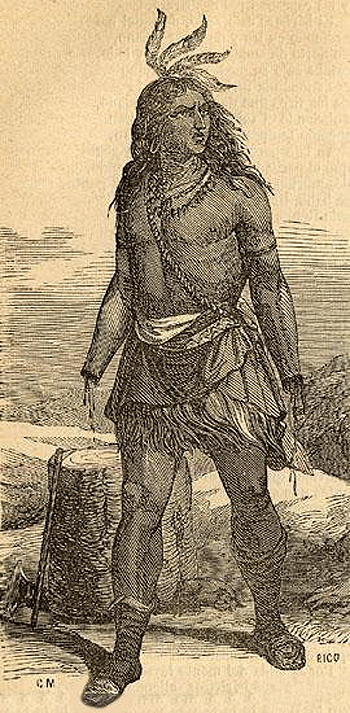



Jeff Wells - December 16th 2015
 |
For as long as there have been wars, there have been warriors who have found a second life on the battlefield. Bloodied, maimed, shot, cut open, stabbed—they are the ones who should have perished, but who nevertheless managed to stay alive and keep fighting. Then there’s Galvarino, a warrior who not only overcame a brutal injury but who actually used it to transform himself into something straight out of your worst nightmare. Five hundred years ago, in what were the early years of South America’s protracted Arauco War, an army of Spanish conquistadors routed several thousand Mapuche Indians in the Battle of Lagunillas, in south central Chile near the Bio Bio River. The Spanish captured 150 Mapuche prisoners, among them a young chieftain named Galvarino, and marched them back to the Spanish encampment. After a swift (and no doubt impartial) trial, Governor Garcia Hurtado de Mendoza, the Spanish leader, ordered troops to sever the right hand and nose of each warrior, and to cut off both hands of leaders like Galvarino. The gruesome act would be a message to the Mapuche: Submit, or else. |
According to Mapuche legend, after Galvarino’s left hand was hacked off, he bravely offered up his right, and watched the hatchet fall without flinching. He then asked his torturers to deliver the killing blow—a request that they declined.
Galvarino and the dozens of other mutilated warriors were then freed, and ordered to tell the Mapuche general Caupolicán to surrender and prevent further bloodshed. Galvarino did no such thing. Instead, he urged Caupolicán and his people to continue to fight against the Spanish intruders. As described by Pedro Mariño de Lobera inChronicle of the Kingdom of Chile, Galvarino went before the Mapuche, handless arms raised in the air, and told them that what had been done to him, the Spanish would do to everyone else if they gave up.
My brethren, why have you stopped fighting these Christians? The damage they have done since they entered our realm, and what they have done to me, is what they will continue to do if we are not diligent in destroying these injurious people.
Such words, Lobera noted, "are often more effective to incite war than the hands of Hercules and the industry of the Caesars." Caupolicán declared that the Mapuche would strike back against the Spaniards, and he named Galvarino as one of his commanders.
But what good would a handless fighter be against the enemy? Very little, as Galvarino knew well. What he did next made him a legend. Before the next offensive, he fastened knives to both of his wrists. There’s no record of how big the knives were, or how sharp, though we’d all no doubt like to imagine long, gleaming blades sprouting from his stumps. Historian Leslie Ray has referred to them as lances, and notes, quite practically, that the Mapuche must have had very effective cauterization techniques to even allow Galvarino to attempt such a feat.
On November 30, 1557, less than a month after his capture, Galvarino was on the frontline of what became known as the Battle of Millarapue. The plan was to ambush the Spanish encampment and overwhelm Mendoza before he could turn his artillery and horses on the warriors. But the Mapuche sprang their trap too quickly, and despite initial success at stymieing Mendoza’s cavalry, the commander managed to hit the native attackers with cannon fire, opening up a seam for his horsemen to ride through and sow chaos. In all, three thousand Mapuche were killed, compared to only minor injuries and scores of dead horses on the Spanish side. There were also several hundred Mapuche captured, Galvarino among them.
There’s little evidence relating Galvarino’s performance during the battle. Jeronimo de Vivar, a Spanish soldier who later wrote an account of the Arauco Wars titledCrónica (Chronicle), wrote that Galvarino motioned his warriors forward with his bladed arms, yelling, “Nobody is allowed to flee but to die, because you die defending your mother country!” (This, like so many other details about Galvarino, was no doubt given an extra flourish.) Vivar also noted that Galvarino went up against Mendoza’s squadron and managed to cut down the general’s second in command.
After the battle, there would be no third chance for Galvarino. He and his men were sentenced to hang. Alonso de Ercilla, a Spanish aide who would later write the epic poem “La Araucana,” claimed that he tried to intervene on Galvarino’s behalf, entreating him to join with the Spanish. To which Galvarino reportedly replied: “I would rather die than live like you, and I’m only sorry that my death will keep me from tearing you to pieces with my teeth.” Some claim Mendoza threw Galvarino to the dogs, while others say he was hanged. Still others believe Galvarino killed himself first to rob his captors of the pleasure.
The Arauco War would continue for nearly 300 years, with the Mapuche continuously resisting colonization by the Spanish. The story of Galvarino was a rallying cry for the Mapuche: “Galvarino’s story has served perhaps more than any other to perpetuate the Mapuches’ reputation for courage and tenacity,”Ray writes in Language of the Land: The Mapuche in Argentina and Chile. In 1825, Chile declared independence from Spain, although resistance against the state continues.
_________________
Source: Mental-Floss